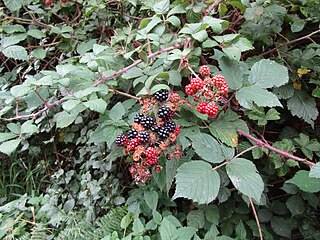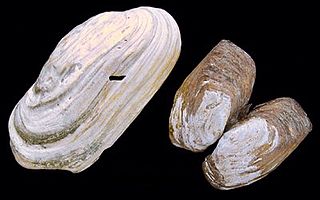
Genus is a taxonomic rank used in the biological classification of living and fossil organisms as well as viruses. In the hierarchy of biological classification, genus comes above species and below family. In binomial nomenclature, the genus name forms the first part of the binomial species name for each species within the genus.

Rubus is a large and diverse genus of flowering plants in the rose family, Rosaceae, subfamily Rosoideae, with over 1,350 species, commonly known as brambles.

Columbidae is a bird family consisting of doves and pigeons. It is the only family in the order Columbiformes. These are stout-bodied birds with short necks and short slender bills that in some species feature fleshy ceres. They primarily feed on plants, and can be taxonomically divided amongst granivores, that feed mostly on the ground on seeds, and frugivores, that feed mostly on fruits, from branches. The family occurs worldwide, often in close proximity with humans, but the greatest variety is in the Indomalayan and Australasian realms.

Kookaburras are terrestrial tree kingfishers of the genus Dacelo native to Australia and New Guinea, which grow to between 28 and 47 cm in length and weigh around 300 g (11 oz). The name is a loanword from Wiradjuri guuguubarra, onomatopoeic of its call. The loud, distinctive call of the laughing kookaburra is widely used as a stock sound effect in situations that involve an Australian bush setting or tropical jungle, especially in older movies.

The Balkan mountain range is a mountain range in the eastern part of the Balkan Peninsula in Southeastern Europe. The range is conventionally taken to begin at the peak of Vrashka Chuka on the border between Bulgaria and Serbia. It then runs for about 560 kilometres (350 mi), first in a south-easterly direction along the border, then eastward across Bulgaria, forming a natural barrier between the northern and southern halves of the country, before finally reaching the Black Sea at Cape Emine. The mountains reach their highest point with Botev Peak at 2,376 metres (7,795 ft).

Mycobacterium is a genus of over 190 species in the phylum Actinomycetota, assigned its own family, Mycobacteriaceae. This genus includes pathogens known to cause serious diseases in mammals, including tuberculosis and leprosy in humans. The Greek prefix myco- means 'fungus', alluding to this genus' mold-like colony surfaces. Since this genus has cell walls with a waxy lipid-rich outer layer that contains high concentrations of mycolic acid, acid-fast staining is used to emphasize their resistance to acids, compared to other cell types.

Stara Zagora, formerly known as the Stara Zagora okrug, is a province of south-central Bulgaria. It is named after its administrative and industrial centre—the city of Stara Zagora—the sixth-biggest town in the country. The province embraces a territory of 5,151.1 km2 (1,988.9 sq mi) that is divided into 11 municipalities with a total population, as of December 2009, of 350,925 inhabitants.

The gallopheasants are pheasants of the family Phasianidae. The genus comprises 11 species and several subspecies. Several species in this genus are known as firebacks, including crestless and crested firebacks, as well as the Siamese fireback.

Stara Zagora is a city in Bulgaria, and the administrative capital of Stara Zagora Province. It is located in the Upper Thracian Plain, near the cities of Kazanlak, Plovdiv, and Sliven. Its population is 121,582 making it the sixth largest city, just below Ruse and above Pleven.

Theobroma is a genus of flowering plants in the mallow family, Malvaceae, that is sometimes classified as a member of Sterculiaceae. It contains roughly 20 species of small understory trees native to the tropical forests of Central and South America.

Casuarina, also known as she-oak, Australian pine and native pine, is a genus of flowering plants in the family Casuarinaceae, and is native to Australia, the Indian subcontinent, Southeast Asia, islands of the western Pacific Ocean, and eastern Africa.

Avicennia is a genus of flowering plants currently placed in the bear's breeches family, Acanthaceae. It contains mangrove trees, which occur in the intertidal zones of estuarine areas and are characterized by its "pencil roots", which are aerial roots. They are also commonly known as api api, which in the Malay language means "fires", a reference to the fact that fireflies often congregate on these trees. Species of Avicennia occur worldwide south of the Tropic of Cancer.

Pass of the Republic, is a mountain pass in the Balkan Mountains in Bulgaria. It connects Veliko Tarnovo and Gurkovo.

Eopsaltria is a genus of small forest passerines known in Australia as the yellow robins. They belong to the Australasian robin family Petroicidae. The name is derived from the Ancient Greek for "dawn singer/song" because of their dawn chorus. They are inquisitive and bold birds, and have been reported perching on the shoulders or boots of people in the bush. Open eucalyptus woodlands are their preferred habitat. The ornithologist John Gould likened the behaviour and mannerisms of the eastern and western yellow robin to those of the European robin. The name "yellow robin" itself was applied to the eastern yellow robin by the early settlers of New South Wales.

Bamboo partridges, sometimes called ridge partridges, are medium-sized non-migratory birds of the genus Bambusicola in the family Phasianidae.They have a wide native distribution throughout Asia. They were formerly grouped in the Perdicinae subfamily of the Phasianidae. However, molecular research suggests that partridges are not a distinct taxon within the family Phasianidae, but that some species are closer to the pheasants, while others are closer to the junglefowl. Phylogenetic evidence supports the bamboo partridges as being the sister genus to the junglefowl.

Notochelone is an extinct genus of sea turtle, which existed about 100 million years ago. The species was first described by Richard Owen in 1882 as Notochelys costata. It was renamed by Richard Lydekker in 1889. It was the most common marine reptile living in the inlands of the sea around Queensland, Australia. It was small turtle with carapace less than 1 metre (3.3 ft). Analytical studies have indicated that the creatures frequently ate benthic molluscs.

Hiatella is a genus of small saltwater clams, marine bivalve molluscs in the family Hiatellidae.

iNaturalist is an American 501(c)(3) nonprofit social network of naturalists, citizen scientists, and biologists built on the concept of mapping and sharing observations of biodiversity across the globe. iNaturalist may be accessed via its website or from its mobile applications. iNaturalist includes an automated species identification tool, and users further assist each other in identifying organisms from photographs. As of 24 February 2024, iNaturalist users had contributed approximately 172,751,520 observations of plants, animals, fungi, and other organisms worldwide, and around 350,000 users were active in the previous 30 days.

Astriclypeidae is a family of echinoderms belonging to the order Clypeasteroida.

Echinodiscus is a genus of sand dollars within the family Astriclypeidae. There are currently 14 species assigned to the genus, with a majority being extinct.




















